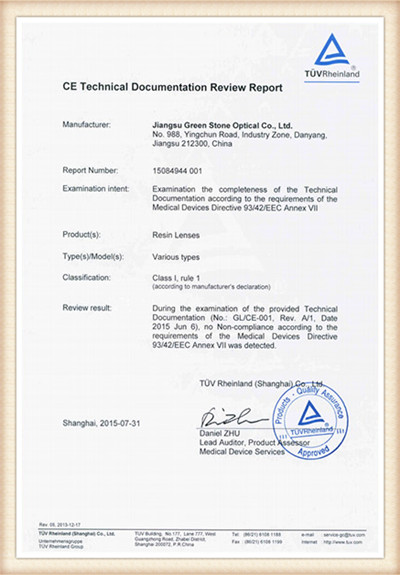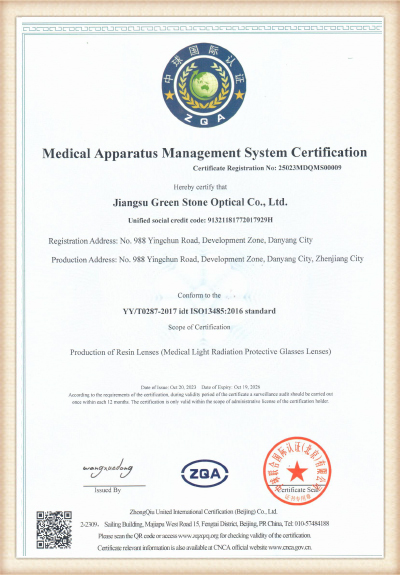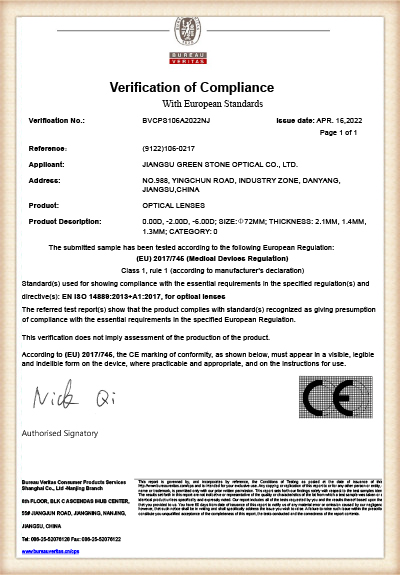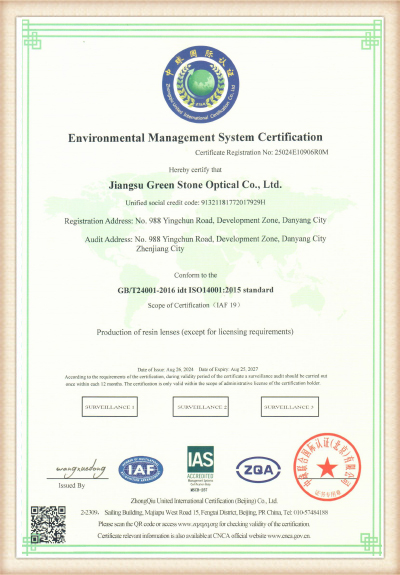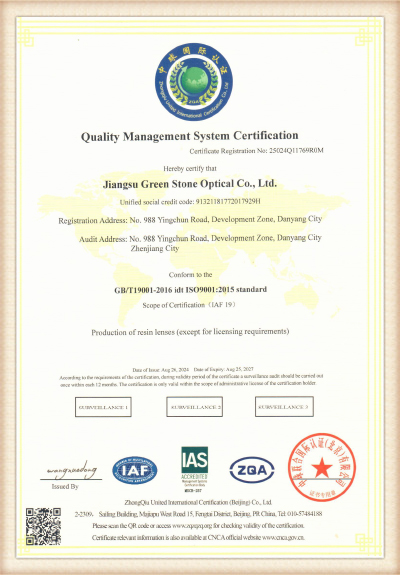Introduction to Core Concepts: The Purpose of Polarized and Photochromic Lenses Advanced lens technologies are designed to enhance visual comfort and protect the eyes from harmful light. Among the many high-quality options, Polarized Lenses and Photochromic Lenses are two of the most popular choices, yet they address d...
READ MORE
Product Series
Prescription Lenses Manufacturers
-


RX 1.499 1.56 1.60 1.67 1.74 Single Vision Progressive Blue Block Round Top Flat Top Bifocal Photochromic Lens
Lens surfaced according to prescriptions in the lens laboratory is cal... -
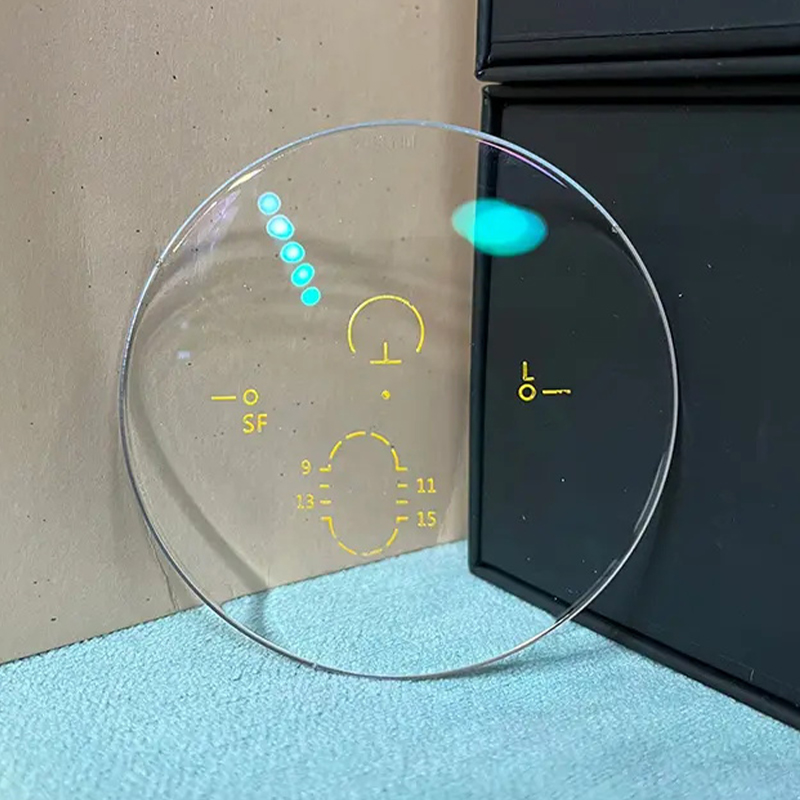

Opto Tech HD Progressive Lenses
The OptoTech HD progressive lens design concentrates the unwanted asti... -
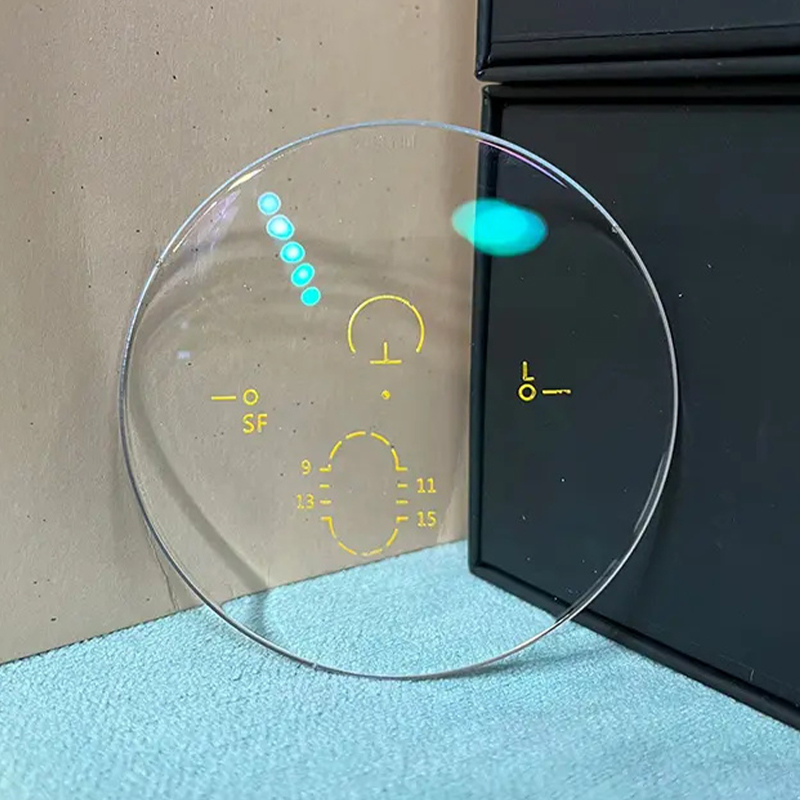

OptoTech SD Freeform Progressive Lenses
The OptoTech SD progressive lens design spreads the unwanted astigmati... -
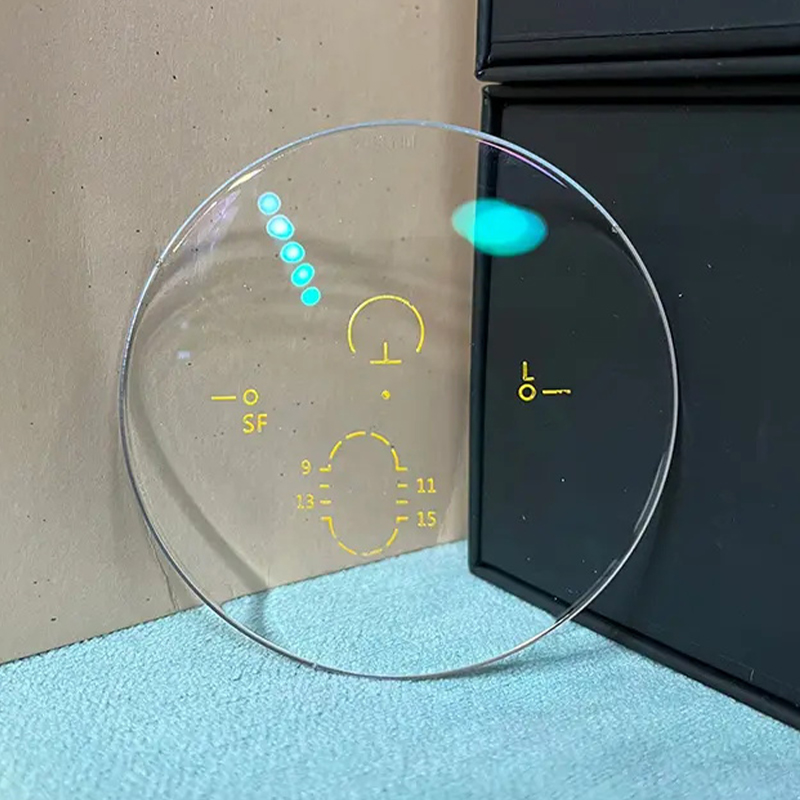

Opto Tech Mild ADD Progressive Lenses
Different eyeglasses accomplish different effects and no lens is best ... -


Opto Tech MD Progressive Lenses
Modern progressive lenses are seldom absolutely hard or absolutely, so... -


Opto Tech Extended IXL Progressive Lenses
A long day in the offce, later on some sports and checking the interne... -


Opto Tech Office 14 Progressive Lenses
In general, an office lens is an optimized reading lens with the abili... -


All Purpose Progressive Lens
Updated design with additional features Our most popular design has ju... -


Desk 2.0 Occupational Lens
New and improved updated design Custom Desk 2.0 offers even wider fiel...
As a high-performance optical lens, RX Lens is widely used in various optometry products. With its excellent optical performance and high-quality materials, it brings users a clear and comfortable visual experience. The lens effectively reduces glare and visual fatigue, and is suitable for the modern lifestyle of long-term use of electronic screens, significantly improving the wearer's visual comfort and work efficiency. Its excellent wear and impact resistance ensures the durability and safety of the lens in daily use, and is suitable for various complex environments and high-intensity use requirements.
RX Lens is highly customized and can meet different vision correction needs, including myopia, hyperopia and astigmatism, ensuring that every user can obtain accurate visual correction effects. This product not only improves the flexibility of glasses, but also greatly reduces the frequency of after-sales adjustment and replacement, helping eyewear manufacturers optimize production processes and reduce costs. RX Lens' advanced anti-reflective coating and high light transmittance ensure excellent visual performance under various lighting conditions both outdoors and indoors, suitable for various professional and daily scene applications.

Our lens products involves almost all types of lenses. Product range covers 1.499, 1.56, 1.60, 1.67, 1.70 and 1.74 index, including single vision,bifocal, progressive, blue cut, Photochromic, blue cut photochromic, Infrared cut etc. with HC, HMC and SHMC treatment. Besides finished lens, We also manufactures semi-finished blanks. The products are registered with CE&FDA and our production certified by ISO9001& ISO14001 standards.
We positively introduce excellent management technology, comprehensively import Corporate Identity System and enhance the external image of company and brand.
-
-
Introducing Normal Lenses and Defocus Lenses In the fields of optics and image capture, the lens is a core component responsible for guiding and shaping light to form an image on a sensor or retina. While all lenses are based on the same laws of physics, their design goals and final effects can vary widely. This articl...
READ MORE -
Unveiling the Technology of Bifocal Lenses Introduction to Bifocal Lenses A bifocal lens is a powerful and time-tested solution in vision correction. Simply put, it is a corrective lens that contains two distinct optical powers within a single lens surface. This design addresses a common challenge faced by millions: ne...
READ MORE
What is RX Lens (Prescription Lens)? What Are the Main Differences compared with Finished Lenses
In the modern optical industry, as consumers’ demand for personalized visual quality continues to increase, RX Lens (Prescription Lens) has become a key trend in optical lens manufacturing. Compared with traditional finished lenses, RX lenses focus more on customization and precision processing. They not only represent the advanced level of optical manufacturing technology but also demonstrate a company’s comprehensive strength in R&D and craftsmanship.
Jiangsu Green Stone Optical Co., Ltd., as a professional optical lens manufacturer integrating R&D, production, and sales, has long been dedicated to innovation and quality enhancement in the field of prescription lenses. The company owns a 65,000-square-meter modern production base equipped with advanced fully automated RX processing lines and free-form surface technology, providing global customers with high-precision, high-performance personalized lens solutions.
I. Definition of RX Lens: Precision Vision with Tailored Design
An RX Lens, also known as a “custom prescription lens,” is a lens designed and manufactured according to the wearer’s personal optical prescription data (including sphere, cylinder, axis, pupillary distance, fitting height, etc.). Unlike finished lenses produced in standard specifications, every RX lens carries unique optical parameters, achieving true “customization for every pair of eyes.”
At Jiangsu Green Stone Optical Co., Ltd., RX lens production relies on advanced free-form surfacing technology, where computer-controlled CNC systems perform micron-level adjustments on the lens curvature to ensure optimal vision across different angles and lighting conditions. This customized approach effectively reduces aberrations, enlarges the clear vision area, and significantly enhances comfort and visual performance.
II. Main Differences Between RX Lenses and Finished Lenses
1. Different Manufacturing Methods
Finished lenses are mass-produced using standard molds with fixed specifications, suitable for conventional prescriptions. RX lenses, however, are customized based on individual prescription data, involving a much more complex process with higher precision requirements. Green Stone Optical uses fully automated CNC systems and high-precision testing equipment to ensure the optical center, curvature, and diopter accuracy of each RX lens meet international standards.
2. Different Visual Effects
Finished lenses are designed for average parameters, which may lead to peripheral distortion, astigmatism, or visual fatigue for individual wearers. RX lenses, by contrast, are optimized based on personal parameters such as pupillary distance, frame shape, and wearing angle, providing a wider, clearer visual field and a smoother visual transition. For example, Green Stone Optical’s free-form progressive RX lenses are optimized according to users’ reading habits and head posture, greatly reducing dizziness and improving visual comfort.
3. Broader Lens Variety
Finished lenses usually come in basic forms such as single vision or progressive. RX lenses, however, can be designed to incorporate multiple functions such as blue-cut, infrared-cut, photochromic, polarized, etc. Green Stone Optical’s RX product range includes refractive indices of 1.499, 1.56, 1.60, 1.67, 1.70, and 1.74, covering single vision, bifocal, progressive, blue cut, photochromic, blue-cut photochromic, and infrared-cut lenses with optional HC, HMC, and SHMC coatings — meeting diverse demands from daily wear to professional applications.
4. Surface Treatment and Durability
Surface coating is a critical step in RX lens manufacturing. Green Stone Optical offers multiple treatments — HC (Hard Coating), HMC (Hard Multi Coating), and SHMC (Super Hydrophobic Multi Coating) — which enhance scratch resistance, reduce reflections, and improve dirt and moisture repellence, ensuring long-term clarity and comfort.
III. Green Stone Optical’s Technological Advantages in RX Lens Manufacturing
1. Full Production Capability – The company manufactures not only finished lenses but also semi-finished blanks, ensuring consistent quality from raw material to final product.
2. Certified Quality System – All products are CE & FDA registered and produced under ISO9001 and ISO14001 standards, ensuring compliance with international quality and environmental requirements.
3. Advanced Equipment & R&D Support – The company has introduced cutting-edge free-form RX production systems and automated coating lines, supported by an experienced R&D team capable of developing customized optical solutions.
4. Global Market Reach – RX lenses are sold both domestically and internationally, exported to Europe, South America, Southeast Asia, the Middle East, and beyond.
RX Lens Production Process
With the continuous development of optical technology, customized visual solutions have become an industry trend. RX lenses (prescription lenses), known for their precision manufacturing and personalized design, represent the high-end segment of the optical lens market. Unlike standard finished lenses, RX lenses integrate data analysis, digital design, high-precision processing, and surface treatment. This process reflects a manufacturer’s strength in technology and innovation.
I. Data Collection – Accurate Prescription as the Starting Point
RX lens manufacturing begins with accurate personal prescription data. Optometrists measure the wearer’s sphere, cylinder, axis, pupillary distance, fitting height, frame shape, and wearing angle. At Jiangsu Green Stone Optical Co., Ltd., these data are imported into advanced RX design software for three-dimensional simulation and ray-tracing analysis, building an individualized visual model for each user. This ensures scientific precision and forms the foundation for accurate visual correction.
II. Design Optimization – Free-Form Technology for Personalized Vision
After data collection, RX lenses enter the design phase. Unlike traditional spherical surfaces, RX lenses use free-form surface technology, automatically generating complex, non-spherical surfaces through computer algorithms to maintain optimal image quality across the entire visual field.
The Green Stone Optical design team uses advanced optical simulation algorithms to optimize lens geometry based on prescription distribution and visual habits. For progressive RX lenses, the design adjusts near, intermediate, and distance vision zones individually, ensuring smoother transitions, wider visual fields, and minimal distortion.
III. Semi-Finished Blank Selection – The Foundation of Optical Stability
High-quality semi-finished blanks are the base for RX lenses. Jiangsu Green Stone Optical Co., Ltd. not only produces finished lenses but also manufactures semi-finished blanks, ensuring high optical purity and material uniformity from the source.
The company provides materials with refractive indices ranging from 1.499, 1.56, 1.60, 1.67, 1.70 to 1.74, selected based on prescription and thickness requirements to balance lightness, durability, and optical performance. After strict inspection, the blanks proceed to the RX line for preliminary processing such as alignment, blocking, rough grinding, and fine polishing.
IV. Free-Form Processing – Core of Digital Precision Manufacturing
The key step in RX production is backside free-form surfacing. Green Stone Optical uses high-precision CNC free-form generators that cut the lens surface at a micron level using ultra-fine diamond tools. Processing is performed in a temperature- and humidity-controlled cleanroom, maintaining extremely low curvature deviations.
After machining, lenses undergo automated polishing, achieving nano-level surface smoothness for superior transparency and image clarity. Each lens is then optically inspected for diopter accuracy, curvature radius, thickness uniformity, and centration to ensure compliance with CE and FDA standards.
V. Coating and Functional Treatment – Combining Performance and Aesthetics
Beyond optical precision, RX lenses require superior durability and comfort. Jiangsu Green Stone Optical Co., Ltd. is equipped with international-grade vacuum coating systems, offering advanced multi-layer surface treatments such as:
- HC (Hard Coating) – Improves scratch resistance.
- HMC (Hard Multi Coating) – Increases light transmittance and reduces reflections.
- SHMC (Super Hydrophobic Multi Coating) – Provides anti-smudge, anti-water, and anti-static properties.
The company can also produce customized RX lenses with blue-cut, infrared-cut, photochromic, and gradient tint functions to meet both functional and aesthetic requirements.
VI. Inspection and Assembly – Ensuring Optical Precision
After coating, RX lenses undergo comprehensive quality inspection. Green Stone Optical implements a full traceability system where every lens is verified for prescription accuracy, transmittance, appearance, and mounting fit to ensure complete compliance with the wearer’s prescription. With ISO9001 and ISO14001 certification, every production step is strictly controlled to guarantee consistency and reliability, achieving global quality standards.
VII. Packaging and Delivery – Efficient Global Distribution
After passing inspection, RX lenses are packaged in anti-static and anti-scratch materials and sorted automatically for shipment. With an efficient supply chain and global logistics network, Jiangsu Green Stone Optical Co., Ltd. exports RX lenses worldwide, including Europe, America, the Middle East, and Southeast Asia, earning an excellent international reputation.
Performance Differences of Different Refractive Indices in RX Lenses
In optical lens manufacturing, refractive index is a fundamental parameter that determines lens performance and visual comfort. For RX lenses (prescription lenses), the refractive index affects not only thickness and weight but also optical clarity, Abbe value, transmittance, and visual comfort. Different refractive indices correspond to specific applications and material advantages.
Jiangsu Green Stone Optical Co., Ltd. offers RX lenses in refractive indices of 1.499, 1.56, 1.60, 1.67, 1.70, and 1.74, covering single vision, bifocal, progressive, blue-cut, photochromic, blue-cut photochromic, and infrared-cut types. With advanced technology and precise control, the company provides complete refractive index solutions, from economic to premium lens types.
1. 1.499 Refractive Index Lenses — Classic Economic Choice
1.499 refractive index lenses, commonly referred to as CR-39 lenses, are the traditional representative of optical resin lenses. They typically have a high Abbe number (around 58), offering excellent optical performance with minimal chromatic aberration. Due to good machining characteristics and moderate cost, 1.499 lenses are commonly used for low-power RX lenses and reading glasses. Green Stone Optical uses high-purity monomers and applies HC/HMC treatments to its 1.499 lenses, providing good scratch resistance and anti-soiling properties, making them popular in entry-level markets.
2. 1.56 Refractive Index Lenses — Balance of Thinness and Cost-Effectiveness
1.56 is one of the most widely used mid-index materials in the market. Compared with 1.499, a 1.56 lens can reduce thickness by approximately 15% and is lighter and mechanically stronger, suitable for higher prescriptions in RX customization. Jiangsu Green Stone Optical Co., Ltd. employs advanced molding and free-form technologies to ensure the optical center and clarity of its 1.56 RX lenses, and provides variants with blue-cut and UV protection coatings to meet diverse market needs.
3. 1.60 Refractive Index Lenses — A Good Balance of Toughness and Transmittance
1.60 lenses are a high-index material that are thinner and lighter than 1.56 while maintaining good impact resistance and machining stability. Their Abbe number is typically around 42, balancing optical clarity and mechanical strength. On Green Stone Optical’s RX production lines, 1.60 lenses are often used for medium-to-high prescriptions and are particularly suitable for progressive lenses or blue-cut coatings. Free-form design is applied to minimize edge distortion and ensure prolonged comfort.
4. 1.67 Refractive Index Lenses — High-End Thin Profile
1.67 lenses are known for high refractive index and elegant appearance, being about 35% thinner than 1.499 lenses and significantly lighter. Although their Abbe number is lower (around 32), advanced multi-layer coatings can effectively reduce glare and chromatic dispersion. Green Stone Optical employs international-grade polishing and coating equipment for 1.67 RX lenses, combined with HMC and SHMC treatments, to provide high transmittance, low reflection, and superior anti-soil performance, making them an ideal option for premium prescription products.
5. 1.70 Refractive Index Lenses — Ultra-Thin with Strong Mechanical Performance
1.70 lenses represent a higher technical threshold in RX manufacturing. Their thinness advantage is significant, particularly suitable for highly myopic patients who need extremely lightweight lenses. Due to higher material hardness and processing requirements, only manufacturers with advanced equipment and experienced technical teams can produce high-quality 1.70 lenses. Green Stone Optical possesses fully automated CNC free-form surfacing systems and temperature- and humidity-controlled cleanrooms to ensure curvature precision and surface quality for 1.70 RX lenses, and its products have obtained CE and FDA recognition, favored by overseas markets.
6. 1.74 Refractive Index Lenses — Ultimate Ultra-Thin Optical Experience
1.74 lenses are among the highest refractive index resin lenses currently available, providing extreme thinness comparable to high-index glass but with much lighter weight and better wearer comfort. Although they typically have a lower Abbe number, Green Stone Optical mitigates chromatic dispersion through optimized optical design and multi-layer coating technology to achieve clear and stable imaging. The company’s 1.74 RX lenses are especially suited for prescriptions stronger than -6.00D, and when combined with SHMC super-hydrophobic multi-coating, they deliver very high transmittance and excellent anti-reflective performance.
Principles for Selecting Refractive Index in RX Lenses
Choosing the appropriate refractive index for an RX lens should consider the wearer’s prescription magnitude, frame size, desired lens thickness/aesthetics, and comfort needs. Generally, lower prescriptions can use 1.499 or 1.56; medium prescriptions may prefer 1.60 or 1.67; and high myopia patients are typically recommended to use 1.70 or 1.74 high-index lenses to achieve the best balance of optical performance and wearer comfort. Jiangsu Green Stone Optical Co., Ltd. offers a full index product lineup and applies free-form personalized design to provide professional visual solutions that help eyewear brands and labs increase product value and competitiveness.
Differences and Applications of HC, HMC, and SHMC Coatings in RX Lenses
In optical lens production, coating technology plays a decisive role in enhancing lens performance, durability, and comfort. Especially for high-end RX lenses (prescription lenses), coating quality directly affects visual clarity, protection, and lifespan. Among various coatings, HC, HMC, and SHMC are the most widely used and representative.
Jiangsu Green Stone Optical Co., Ltd. has a comprehensive coating system and advanced international equipment capable of providing tailored HC, HMC, and SHMC multilayer coatings for different refractive indices and functional needs. The company’s RX products—covering 1.499, 1.56, 1.60, 1.67, 1.70, and 1.74 indices—are available in single vision, bifocal, progressive, blue-cut, photochromic, and infrared-cut series, all CE and FDA certified, and produced under ISO9001 and ISO14001 international standards.
HC (Hard Coating) — Fundamental Surface Protection
HC (Hard Coating) is the basic and crucial protective treatment for resin-based lenses. Uncoated resin lenses are relatively soft and easily scratched by dust, cloth, or small particles. By applying a high-hardness silicone-based coating and curing it under controlled conditions, the surface hardness and abrasion resistance of the lens are significantly improved.
On Green Stone Optical production lines, HC processing includes automated cleaning, plasma decontamination, and controlled curing to ensure uniform coating and strong adhesion. HC-treated RX lenses exhibit:
- Substantially improved scratch resistance, extending service life;
- High transmittance, preserving the lens’s original optical properties;
- Cost-effectiveness, suitable for daily-use and entry-level RX lenses.
Application Scenarios: HC-treated lenses are commonly used in cost-sensitive markets, basic prescription eyewear, and scenarios requiring moderate surface protection, such as low-power single-vision RX lenses and reading spectacles.
HMC (Hard Multi Coating) — Enhanced Anti-Reflective Performance
HMC (Hard Multi Coating) builds on the HC base by adding multiple anti-reflective layers. In a high-vacuum environment, alternating layers of optical materials with different refractive indices are deposited to utilize interference effects that reduce surface reflections and increase light transmission, delivering clearer vision with truer color rendering.
Green Stone Optical uses precision vacuum coaters and nano-level layer control in its HMC process to maintain consistent film thickness and strong adhesion, achieving reflectance levels below 1.0% in many cases. HMC advantages include:
- Brighter visual perception due to increased transmittance;
- Reduced glare and reflections from screens and bright light sources;
- Improved wear resistance and anti-soiling when reinforced layers are incorporated.
Application Scenarios: HMC is suitable for users requiring high visual clarity and anti-reflection, such as office workers, students, night drivers, and heavy digital device users. Green Stone Optical’s blue-cut HMC RX lenses are particularly popular, offering eye protection without sacrificing transmittance.
SHMC (Super Hydrophobic Multi Coating) — Premium Water- and Dirt-Repellent Protection
SHMC (Super Hydrophobic Multi Coating) represents the high-end tier of coating technology. SHMC applies a hydrophobic nano-layer on top of the HMC stack to impart water, oil, and dirt repellency, as well as anti-static properties.
When water or oil contacts an SHMC-coated surface, it beads up and rolls off (the “lotus effect”), leaving little residue and making the lens easier to clean. Jiangsu Green Stone Optical Co., Ltd. implements advanced vacuum plasma coating technologies and precise nano-layer thickness control to ensure the durability and optical uniformity of SHMC layers. Key SHMC benefits include:
- Excellent water and dust resistance;
- Strong anti-static and anti-soiling performance, reducing dust adhesion;
- Very high transmittance (often exceeding 99%), providing natural and sharp imaging;
- Easy cleaning and user convenience due to reduced residue adhesion.
Application Scenarios: SHMC-coated lenses are ideal for premium RX customizations such as progressive lenses, blue-cut photochromic lenses, and high-index ultra-thin lenses, particularly suited for professional users and high-end consumers who demand both superior optical quality and ease of maintenance.
Green Stone Optical’s Coating Capabilities
Jiangsu Green Stone Optical Co., Ltd. operates a complete coating production line from HC hardening to HMC anti-reflection stacks and SHMC super-hydrophobic finishes. All coatings are applied in temperature- and humidity-controlled cleanrooms. The company utilizes international high-vacuum coaters and automated inspection systems to ensure film uniformity, adhesion, and high transmittance.
Importantly, Green Stone Optical matches coating recipes to different refractive indices (from 1.499 to 1.74) so that even high-index, ultra-thin RX lenses maintain outstanding scratch resistance, anti-reflection, and anti-soiling performance. This comprehensive capability has established Green Stone Optical as a reliable partner for global optical brands and lens processing centers.



 English
English Español
Español



